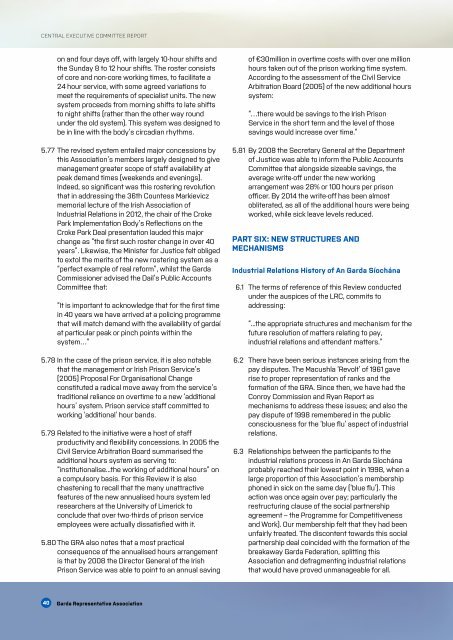Conference Report 2016
Table of contents contains links on page 5. It can be used to skip through chapters.
Table of contents contains links on page 5. It can be used to skip through chapters.
You also want an ePaper? Increase the reach of your titles
YUMPU automatically turns print PDFs into web optimized ePapers that Google loves.
CENTRAL EXECUTIVE COMMITTEE REPORT<br />
on and four days off, with largely 10-hour shifts and<br />
the Sunday 8 to 12 hour shifts. The roster consists<br />
of core and non-core working times, to facilitate a<br />
24 hour service, with some agreed variations to<br />
meet the requirements of specialist units. The new<br />
system proceeds from morning shifts to late shifts<br />
to night shifts (rather than the other way round<br />
under the old system). This system was designed to<br />
be in line with the body’s circadian rhythms.<br />
5.77 The revised system entailed major concessions by<br />
this Association’s members largely designed to give<br />
management greater scope of staff availability at<br />
peak demand times (weekends and evenings).<br />
Indeed, so significant was this rostering revolution<br />
that in addressing the 36th Countess Markievicz<br />
memorial lecture of the Irish Association of<br />
Industrial Relations in 2012, the chair of the Croke<br />
Park Implementation Body’s Reflections on the<br />
Croke Park Deal presentation lauded this major<br />
change as “the first such roster change in over 40<br />
years”. Likewise, the Minister for Justice felt obliged<br />
to extol the merits of the new rostering system as a<br />
“perfect example of real reform”, whilst the Garda<br />
Commissioner advised the Dail’s Public Accounts<br />
Committee that:<br />
“It is important to acknowledge that for the first time<br />
in 40 years we have arrived at a policing programme<br />
that will match demand with the availability of gardaí<br />
at particular peak or pinch points within the<br />
system…”<br />
5.78 In the case of the prison service, it is also notable<br />
that the management or Irish Prison Service’s<br />
(2005) Proposal For Organisational Change<br />
constituted a radical move away from the service’s<br />
traditional reliance on overtime to a new ‘additional<br />
hours’ system. Prison service staff committed to<br />
working ‘additional’ hour bands.<br />
5.79 Related to the initiative were a host of staff<br />
productivity and flexibility concessions. In 2005 the<br />
Civil Service Arbitration Board summarised the<br />
additional hours system as serving to:<br />
“institutionalise...the working of additional hours” on<br />
a compulsory basis. For this Review it is also<br />
chastening to recall that the many unattractive<br />
features of the new annualised hours system led<br />
researchers at the University of Limerick to<br />
conclude that over two-thirds of prison service<br />
employees were actually dissatisfied with it.<br />
5.80 The GRA also notes that a most practical<br />
consequence of the annualised hours arrangement<br />
is that by 2008 the Director General of the Irish<br />
Prison Service was able to point to an annual saving<br />
of €30million in overtime costs with over one million<br />
hours taken out of the prison working time system.<br />
According to the assessment of the Civil Service<br />
Arbitration Board (2005) of the new additional hours<br />
system:<br />
“…there would be savings to the Irish Prison<br />
Service in the short term and the level of those<br />
savings would increase over time.”<br />
5.81 By 2008 the Secretary General at the Department<br />
of Justice was able to inform the Public Accounts<br />
Committee that alongside sizeable savings, the<br />
average write-off under the new working<br />
arrangement was 28% or 100 hours per prison<br />
officer. By 2014 the write-off has been almost<br />
obliterated, as all of the additional hours were being<br />
worked, while sick leave levels reduced.<br />
PART SIx: NEw STRuCTuRES AND<br />
mEChANISmS<br />
Industrial Relations history of An Garda Síochána<br />
6.1 The terms of reference of this Review conducted<br />
under the auspices of the LRC, commits to<br />
addressing:<br />
“...the appropriate structures and mechanism for the<br />
future resolution of matters relating to pay,<br />
industrial relations and attendant matters.”<br />
6.2 There have been serious instances arising from the<br />
pay disputes. The Macushla ‘Revolt’ of 1961 gave<br />
rise to proper representation of ranks and the<br />
formation of the GRA. Since then, we have had the<br />
Conroy Commission and Ryan <strong>Report</strong> as<br />
mechanisms to address these issues; and also the<br />
pay dispute of 1998 remembered in the public<br />
consciousness for the ‘blue flu’ aspect of industrial<br />
relations.<br />
6.3 Relationships between the participants to the<br />
industrial relations process in An Garda Síochána<br />
probably reached their lowest point in 1998, when a<br />
large proportion of this Association’s membership<br />
phoned in sick on the same day (‘blue flu’). This<br />
action was once again over pay; particularly the<br />
restructuring clause of the social partnership<br />
agreement – the Programme for Competitiveness<br />
and Work). Our membership felt that they had been<br />
unfairly treated. The discontent towards this social<br />
partnership deal coincided with the formation of the<br />
breakaway Garda Federation, splitting this<br />
Association and defragmenting industrial relations<br />
that would have proved unmanageable for all.<br />
40 Garda Representative Association




